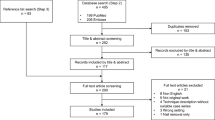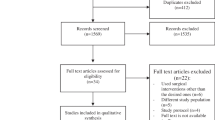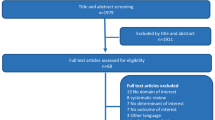Abstract
Purpose
To report the statistical stability of prospective clinical trials evaluating the effect of intramedullary reaming on rates of non-union in tibial fractures through calculation of the fragility metrics for non-union rates and all other dichotomous outcomes.
Methods
Literature search was conducted for prospective clinical trials evaluating the effect of intramedullary reaming on non-union rates in tibial nailing. All dichotomous outcomes were extracted from the manuscripts. The fragility index (FI) and reverse fragility index (RFI) were calculated by determining the number of event reversals required for a statistically significant outcome to lose significance and vice-versa. The fragility quotient (FQ) and reverse fragility quotient (RFQ) were calculated by dividing the FI or RFI by the sample size, respectively. Outcomes were defined as “fragile” if the FI or RFI was found to be less than or equal to the number of patients lost to follow-up.
Results
Literature search identified 579 results which produced ten studies meeting the criteria for review. There were 111 outcomes identified for analysis, of which 89 (80%) exhibited statistical fragility. For reported outcomes across the studies the median and mean FI was 2, the median FQ was 0.019, the mean FQ was 0.030, the median RFI was 4, the mean RFI was 3.95, the median RFQ was 0.045, and the mean RFQ was 0.030. Four studies reported outcomes which were found to have an FI of 0.
Conclusions
The studies evaluating the effect of intramedullary reaming on tibial nail fixation demonstrate considerable fragility. On average, two event reversals for significant findings, and four event reversals for insignificant findings are sufficient to alter statistical significance.
Level of evidence
Level II, systematic review of Level I and Level II studies.

Similar content being viewed by others
Data availability
The dataset generated for this study is available by request.
References
Miller NC, Askew AE. Tibia fractures. an overview of evaluation and treatment. Orthop Nurs. 2007;26(4):216–23. https://doi.org/10.1097/01.NOR.0000284648.52968.27 (quiz 224–5).
Schmidt AH, Finkemeier CG, Tornetta P 3rd. Treatment of closed tibial fractures. Instr Course Lect. 2003;52:607–22.
Gregory P, Sanders R. The treatment of closed, unstable tibial shaft fractures with unreamed interlocking nails. Clin Orthop Relat Res. 1995;315:48–55.
Abdullah L, Davis DE, Fabricant PD, et al. Is there truly “no significant difference”? Underpowered randomized controlled trials in the orthopaedic literature. J Bone Jt Surg Am. 2015;97(24):2068–73. https://doi.org/10.2106/JBJS.O.00012.
Ioannidis JP. Why most published research findings are false. PLoS Med. 2005;2(8):e124.1.
Scott J, Checketts JX, Cooper CM, Boose M, Wayant C, Vassar M. An evaluation of publication bias in high-impact orthopaedic literature. JB JS Open Access. 2019;4(2):e0055. https://doi.org/10.2106/JBJS.OA.18.00055.
Gaudino M, Hameed I, Rahouma M, Khan FM, Tam DY, Biondi-Zoccai G, Demetres M, Charlson ME, Ruel M, Crea F, Falk V. Characteristics of contemporary randomized clinical trials and their association with the trial funding source in invasive cardiovascular interventions. JAMA Intern Med. 2020;180(7):993–1001.
Clark D, Vo LU, Piscoya AS, et al. Systematic review and analysis of the quality of randomized controlled trials comparing reamed and unreamed intramedullary nailing of tibial fractures. J Orthop Trauma. 2021;35(2):59–64. https://doi.org/10.1097/BOT.0000000000001910.
Ioannidis JP. Contradicted and initially stronger effects in highly cited clinical research. JAMA. 2005;294(2):218–28.
Walsh M, Srinathan SK, McAuley DF, et al. The statistical significance of randomized controlled trial results is frequently fragile: a case for a Fragility Index. J Clin Epidemiol. 2014;67(6):622–8.
Khan MS, Fonarow GC, Friede T, et al. Application of the reverse fragility index to statistically nonsignificant randomized clinical trial results. JAMA Netw Open. 2020;3(8): e2012469.
Ahmed W, Fowler RA, McCredie VA. Does sample size matter when interpreting the fragility index? Crit Care Med. 2016;44(11):e1142–3.
Khan M, Evaniew N, Gichuru M, et al. The fragility of statistically significant findings from randomized trials in sports surgery: a systematic survey. Am J Sports Med. 2017;45(9):2164–70. https://doi.org/10.1177/0363546516674469. (epub 2016 Dec 14).
Khormaee S, Choe J, Ruzbarsky JJ, et al. The fragility of statistically significant results in pediatric orthopaedic randomized controlled trials as quantified by the fragility index: a systematic review. J Pediatr Orthop. 2018;38(8):e418–23. https://doi.org/10.1097/BPO.0000000000001201.
Parisien RL, Trofa DP, Dashe J, et al. Statistical fragility and the role of p values in the sports medicine literature. J Am Acad Orthop Surg. 2019;27(7):e324–9. https://doi.org/10.5435/JAAOS-D-17-00636.
Parisien RL, Dashe J, Cronin PK, et al. Statistical significance in trauma research: too unstable to trust? J Orthop Trauma. 2019;33(12):e466–70. https://doi.org/10.1097/BOT.0000000000001595.
Forrester LA, McCormick KL, Bonsignore-Opp L, Tedesco LJ, Baranek ES, Jang ES, Tyler WK. Statistical fragility of surgical clinical trials in orthopaedic trauma. J Am Acad Orthop Surg Glob Res Rev. 2021;5(11):e20.00197. https://doi.org/10.5435/JAAOSGlobal-D-20-00197.
Ruzbarsky JJ, Khormaee S, Daluiski A. The Fragility Index in hand surgery randomized controlled trials. J Hand Surg Am. 2019;44(8):698.e1-698.e7. https://doi.org/10.1016/j.jhsa.2018.10.005. (epub 2018 Nov 9).
Ekhtiari S, Gazendam AM, Nucci NW, et al. The fragility of statistically significant findings from randomized controlled trials in hip and knee arthroplasty. J Arthroplasty. 2021;36(6):2211-2218.e1. https://doi.org/10.1016/j.arth.2020.12.015. (Epub 2020 Dec 13).
Evaniew N, Files C, Smith C, et al. The fragility of statistically significant findings from randomized trials in spine surgery: a systematic survey. Spine J. 2015;15(10):2188–97. https://doi.org/10.1016/j.spinee.2015.06.004. (epub 2015 Jun 11).
Forrester LA, Jang E, Lawson MM, et al. Statistical fragility of surgical and procedural clinical trials in orthopaedic oncology. J Am Acad Orthop Surg Glob Res Rev. 2020;4(6):e19.00152. https://doi.org/10.5435/JAAOSGlobal-D-19-00152.
Choudary D, Kanthimathi B. A prospective comparative study of reamed vs. unreamed nailing in fractures shaft of tibia. Malays Orthop J. 2012;6(3):21–6. https://doi.org/10.5704/MOJ.1207.016.
Trlica J, Kočí J, Lochman P, et al. Reamed versus unreamed nail in the treatment of tibia shaft fractures. Eur J Trauma Emerg Surg. 2014;40(4):489–93. https://doi.org/10.1007/s00068-013-0340-0. (epub 2013 Oct 15).
Bhandari M, Guyatt G, Study to prospectively evaluate reamed intramedullary nails in patients with tibial fractures investigators, et al. : Randomized trial of reamed and unreamed intramedullary nailing of tibial shaft fractures. J Bone Jt Surg Am. 2008;90(12):2567–78. https://doi.org/10.2106/JBJS.G.01694.
Court-Brown CM, Will E, Christie J, et al. Reamed or unreamed nailing for closed tibial fractures. A prospective study in Tscherne C1 fractures. J Bone Jt Surg Br. 1996;78(4):580–3.
Blachut PA, O’Brien PJ, Meek RN, et al. Interlocking intramedullary nailing with and without reaming for the treatment of closed fractures of the tibial shaft. A prospective, randomized study. J Bone Jt Surg Am. 1997;79(5):640–6. https://doi.org/10.2106/00004623-199705000-00002.
Finkemeier CG, Schmidt AH, Kyle RF, et al. A prospective, randomized study of intramedullary nails inserted with and without reaming for the treatment of open and closed fractures of the tibial shaft. J Orthop Trauma. 2000;14(3):187–93. https://doi.org/10.1097/00005131-200003000-00007.
Keating JF, O’Brien PJ, Blachut PA, et al. Locking intramedullary nailing with and without reaming for open fractures of the tibial shaft. A prospective, randomized study. J Bone Jt Surg Am. 1997;79(3):334–41. https://doi.org/10.2106/00004623-199703000-00003.
Larsen LB, Madsen JE, Høiness PR, et al. Should insertion of intramedullary nails for tibial fractures be with or without reaming? A prospective, randomized study with 3.8 years’ follow-up. J Orthop Trauma. 2004;18(3):144–9. https://doi.org/10.1097/00005131-200403000-00003.
Deleanu B, Prejbeanu R, Poenaru D, et al. Reamed versus unreamed intramedullary locked nailing in tibial fractures. Eur J Orthop Surg Traumatol. 2014;24(8):1597–601. https://doi.org/10.1007/s00590-013-1401-0. (epub 2014 Jan 3).
Sadighi A, Elmi A, Jafari MA, Sadeghifard V, Goldust M. Comparison study of therapeutic results of closed tibial shaft fracture with intramedullary nails inserted with and without reaming. Pak J Biol Sci. 2011;14(20):950–3. https://doi.org/10.3923/pjbs.2011.950.953.
Santos CMD, Prada L, David C, et al. Antithrombotic therapy recommendations in the European Society of Cardiology Guidelines: how robust are the randomized controlled trials underpinning them? TH Open. 2021;5(2):e125–33. https://doi.org/10.1055/s-0041-1725043.
Khan MS, Ochani RK, Shaikh A, et al. Fragility index in cardiovascular randomized controlled trials. Circ Cardiovasc Qual Outcomes. 2019;12(12):e005755.
Chapman C, Howard B, Wayan C, Vassar M. An analysis of fragility and risk of bias in randomized clinical trials in bowel preparation guidelines. J Clin Gastroenterol Hepatol. 2018;2(3):17. https://doi.org/10.21767/2575-7733.1000046.
Tignanelli CJ, Napolitano LM. The fragility index in randomized clinical trials as a means of optimizing patient care. JAMA Surg. 2019;154(1):74–9. https://doi.org/10.1001/jamasurg.2018.4318.
Hasenboehler EA, Choudhry IK, Newman JT, et al. Bias towards publishing positive results in orthopedic and general surgery: a patient safety issue? Patient Saf Surg. 2007;1(1):4. https://doi.org/10.1186/1754-9493-1-4.PMID:18271997;PMCID:PMC2241774.
Scott J, Checketts JX, Cooper CM, et al. An evaluation of publication bias in high-impact orthopaedic literature. JB JS Open Access. 2019;4(2):e0055. https://doi.org/10.2106/JBJS.OA.18.00055.
Kim HY. Statistical notes for clinical researchers: Chi-squared test and Fisher’s exact test. Restor Dent Endod. 2017;42(2):152–5. https://doi.org/10.5395/rde.2017.42.2.152.
Caldwell JME, Youssefzadeh K, Limpisvasti O. A method for calculating the fragility index of continuous outcomes. J Clin Epidemiol. 2021;136:20–5.
Author information
Authors and Affiliations
Corresponding author
Ethics declarations
Conflict of interest
This manuscript has not received grant funding, and no authors have any financial or nonfinancial conflicts of interest to disclose.
Rights and permissions
Springer Nature or its licensor (e.g. a society or other partner) holds exclusive rights to this article under a publishing agreement with the author(s) or other rightsholder(s); author self-archiving of the accepted manuscript version of this article is solely governed by the terms of such publishing agreement and applicable law.
About this article
Cite this article
Minhas, A., Berkay, F., Ehlers, C.B. et al. The statistical fragility of intramedullary reaming in tibial nail fixation: a systematic review. Eur J Trauma Emerg Surg 49, 2347–2354 (2023). https://doi.org/10.1007/s00068-023-02254-4
Received:
Accepted:
Published:
Issue Date:
DOI: https://doi.org/10.1007/s00068-023-02254-4




